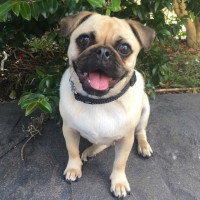Appearance of the Tibetan Pug
|
| The Tibetan Pug is a small dog. It usually weighs no more than fourteen pounds as an adult. However, if its parents are slightly larger, it can weigh up to 7 kilos. His coloring will also largely depend on the coat color of his parents. It can be black, brown and white, light brown or cream. It can also be red or brindle. Its coat will be short and straight. His ears may be floppy, in which case you'll need to spend a little more time caring for them. His eyes are large and brown, and may have a tendency to pop out of their sockets. Their muzzle is generally quite short, and they may inherit the brachycephalic tendencies of the Pug's parent breed. It can also appear short and stocky like its Pug relative. Its tail may also feature the high corkscrew characteristic of the Pug's parent breed. |
Temperament of the Tibetan Pug
|
| The Tibetan Pug is a gentle, happy little dog. They get on well with most people and animals they meet. He's particularly good with children. He tends to bark a lot, which is why he's generally considered an excellent watchdog. He loves to learn tricks, and is often happiest when showing what he's learned to family and friends. They are highly intelligent and often curious about their surroundings. He can often be found following family members from room to room, just to be in the middle of family activities. He loves to play, and enjoys interacting with people and other animals. He's very affectionate; he's often referred to as a wonderful lap dog because he'll climb into your lap at the slightest opportunity. He's easily housebroken, and his propensity for learning tricks makes him easy to train in other areas too. |
Needs and activities of the Tibetan Pug
|
| The Tibetan Pug is a dog that doesn't need much activity. He loves to learn tricks and perform at all times, but is never considered hyperactive. He'll enjoy short, brisk walks around the neighborhood with you. He'll also enjoy outings to the dog park. It's important to remember that the Tibetan Pug can inherit the brachycephalic muzzle of the parent breed Pug. In this case, you'll need to keep water on hand, especially during the summer months, to keep him hydrated. This will also prevent him from getting too hot, which can be a real problem for a dog with a short muzzle. Never let the Tibetan Pug overexert himself; he may not be able to breathe properly. Invest in toys that will occupy his mind and provide physical stimulation at the same time. |
Maintenance of the Tibetan Pug
|
| The Tibetan Pug is a low-maintenance dog. Its coat is often short, silky and smooth. Brush weekly to remove dead hairs. He tends to shed more in autumn and spring, so you may need to brush him daily at these times of year. Bathe him only when necessary. His natural oils will keep his coat shiny and healthy. To prevent bad breath and tartar build-up, brush your dog's teeth two or three times a week. However, to prevent cavities, brush his teeth every day. If he has inherited protruding ears, you'll need to clean his ears with a damp cotton ball, using warm water to moisten it, every week. At this point, check for redness or odor. If either of these signs is present, your dog may be developing an ear infection. Clip his nails every two or three weeks. In general, if you hear his nails clicking on a tiled floor, it's time to trim them. |









 English (United Kingdom)
English (United Kingdom)